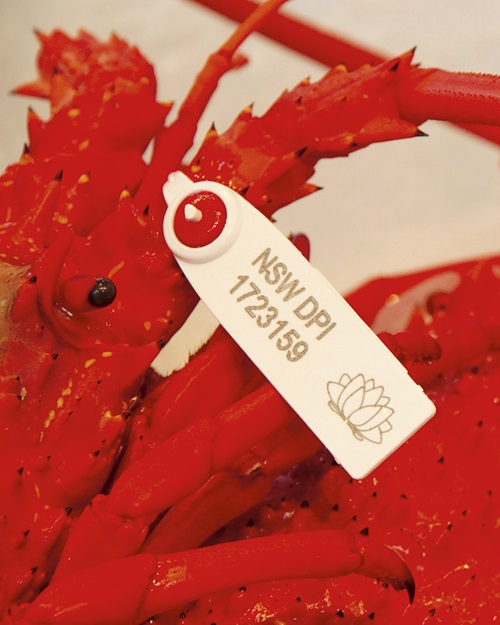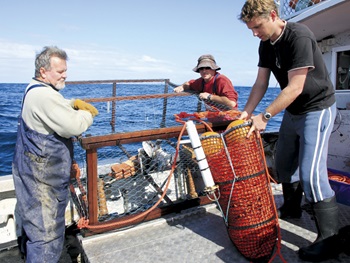Stock assessments, new technology, biotoxin warnings and international marketing were all on the agenda for rocklobster industry participants attending the 8th Rock Lobster Congress in Sydney in September
By Daryl Sykes
 Tagging is part of efforts to monitor and rebuild the NSW rocklobster fishery.
Tagging is part of efforts to monitor and rebuild the NSW rocklobster fishery. Photos: Geogg Liggins
More than 230 rocklobster industry participants, researchers and fisheries managers from Australia and New Zealand gathered at Darling Harbour, New South Wales, in September for the 8th Rock Lobster Congress, to discuss challenges and future directions for the industry.
The event also incorporated the Trans-Tasman Rock Lobster Conference, the second time it has formally been held as a joint event with the New Zealand industry.
The exchange of information, ideas and aspirations aimed to streamline and accelerate stock rebuilding initiatives, improve industry productivity and enable greater efficiency gains in terms of research and compliance across the various fisheries’ jurisdictions.
The theme of the 2013 congress was ‘Meeting new challenges with confidence’ – adapting to changing political priorities and preferences for access to and use of marine resources. It builds on the work of the 2011 Trans-Tasman Rock Lobster Congress, working with industry professionals to guide and inform industry responses to challenges and opportunities.
FRDC executive director Patrick Hone opened the proceedings, encouraging delegates to share the vision to grow industry value.
He gave a commitment from the FRDC to assist industry through a range of programs directed at supporting co-management, investing in people, promoting science, supporting industry partnerships and consolidating the FRDC as an even more efficient service agency.
Keith Sainsbury, professor of marine management systems at the Institute for Marine and Antarctic Sciences, paid tribute to the NSW rocklobster industry in his presentation ‘A Management Success and Lessons Learned’.
He said the patience and cooperation of the industry – the open and productive relationships between industry, science and fisheries managers – were critical to ongoing efforts to rebuild the NSW fishery.
When faced with challenges to the resource, he said industry engaged constructively with the implementation of changes needed to address these challenges.
In the ‘State of the States’ segment, presenters highlighted current issues in their own fisheries. John Harrison, attending his first Rock Lobster Congress as chief executive officer of the Western Rock Lobster Council, outlined the challenge of cetacean interactions (whales, dolphins and porpoises) and possible responses from the Western Rocklobster (Panulirus cygnus) industry.
In a subsequent research and technology presentation, Geoff Liggins from the NSW Department of Primary Industries (DPI) and NSW rocklobster fisher Scott Westley presented a summary of field trials of sonar release buoys deployed in the offshore rocklobster fishery along the NSW coast.
There was significant interest in these devices as a possible means of avoiding cetacean entanglements in rocklobster gear, but the current cost of the technology may prove to be a barrier to widespread use.
Picking up on the FRDC theme of growing industry value, Tim Ward and Rick McGarvey from the South Australian Research and Development Institute (SARDI) outlined the development and application of maximum economic yield approaches to rocklobster stock assessments.
Some delegates were concerned that fishery modellers have yet to properly understand the subtleties and complexities of the rocklobster fishing business.
Tim Ward agreed that model design and projections could only get better as industry participants made more detailed and timely information available to researchers.
Two presenters from New Zealand took up the theme of industry-generated data and the manner in which it can be stored and used.
Jeremy Cooper from the Paua Industry Council showed electronic data collection technology developed for the New Zealand abalone and rocklobster industries, which is being used to collect information for stock assessments and to inform industry harvest initiatives.
Mark Jones from Commercial Fisheries Services Ltd explained how storage and access to industry-generated data could be both secure and cost-effective. He also explained related intellectual property, privacy and security considerations.
Day two of the conference began with a marine biotoxin management workshop convened by Alison Turnbull from SARDI. The session built on the closures experienced by the entire Tasmanian rocklobster fishery and a component of New Zealand’s Bay of Plenty fishery in 2012 following biotoxin events.
This was followed by a ‘Fishnet Forum’, which brought together female managers from industry and state agencies in a discussion facilitated by Nici Gibbs, formerly a senior policy manager for the New Zealand seafood industry.
 (From left) Mal Gorry, Scott Westley and a crewman deploying deep water traps with sonar release from vessel Spinaway II on the NSW south coast – the new technology was featured at the Rock Lobster Congress.
(From left) Mal Gorry, Scott Westley and a crewman deploying deep water traps with sonar release from vessel Spinaway II on the NSW south coast – the new technology was featured at the Rock Lobster Congress. Themes to emerge from the forum were the need for industry to be well organised, have proper mandate and demonstrate a willingness to engage consistently and productively with management agencies.
Perhaps one of the most graphic descriptions of challenges and how best to meet them came from SA delegates Joel Redman and Kyri Toumazos. The video presentation ‘Drawing the Line’ focused on the SA rocklobster industry and was developed in response to Australia’s marine protected areas policies.
Wayne Hosking from Geraldton, Western Australia, gave another presentation contrasting the pragmatic observations and conclusions of the Western Rocklobster industry participants with the more theoretical management responses developed by the WA Department of Fisheries.
He concluded that the worst effects of historical management interventions on industry may have been avoided if better communication and understanding had prevailed at the time.
Market value
Australian rocklobster fisheries generate a landed value in excess of A$404 million, ranking as the most economically valuable of the Australian wild-catch fisheries. New Zealand rocklobster exports generated an estimated NZ$220 million (A$191 million) in 2012-13 and the rocklobster fisheries remain the most economically valuable of all New Zealand inshore fisheries.
The significant majority of rocklobster production from both countries is exported and the price paid to fishers for their catches is determined by the quality and status of Spiny Rocklobsters in the ever more competitive Chinese market.
Two presentations again highlighted the capacity of the Chinaese market to absorb an increasing tide of rocklobster products from the Americas, South Africa and Asia.
Positioning trans-Tasman rocklobster production as the premium luxury choice for wealthy consumers is part of the work being coordinated by the Australian Seafood Cooperative Research Centre, supported by the China Trade Reference Group.
Group member Nathan Maxwell-McGinn provided delegates with insight and advice on tapping into the hearts and minds of the most discerning consumers. Andrew Harvey from Ngai Tahu Seafoods provided an illuminating and perceptive account of doing business in China.
Feedback on the conference from delegates and speakers was positive and the organising committee was encouraged by the financial and other support of the two major sponsors, the FRDC and the NSW DPI, and from participating industry representative organisations.
These included the NSW Lobster Industry Association, the New Zealand Rock Lobster Industry Council, the Western Rock Lobster Council, the SA Rock Lobster Advisory Council and the Tasmanian Rock Lobster Fishermen’s Association.
Several industry service providers also supported the event and set up colourful and informative trade displays.
The Western Rocklobster industry will host the 2015 event, which will be the ninth Rock Lobster Congress, and third Trans-Tasman Rock Lobster Industry Conference.
*Daryl Sykes is the executive officer of the New Zealand Rock Lobster Industry Council.
FRDC Research Code: 2013-411
More information
Daryl Sykes, lobster@seafood.co.nz





